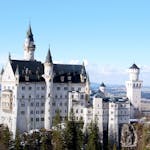Midwesterners might grimace at how rough winters can get these days, but 20,000 years ago much of the region was under a sheet of ice thicker than a mile in some places. One of the most fascinating marks it left as the ice melted was Wisconsin's Kettle Moraine.
A "kettle" forms when debris from a grinding glacier gathers in a deposit as the ice melts away. In this case, a large chunk of ice at the center lasts a bit longer under the pile and when it finally does shrink, it creates a sunken bowl-shaped middle to the moraine. This long north-to-south area between the crushing forces of two major ice lobes — the Green Bay and Lake Michigan lobes — is so rife with them that the entire region took the term as a proper name.
Geneva and Pike lakes are two of the largest kettles. The extensive collection of moraines, eskers and kames is a natural geological textbook, and much of it has been set aside as a Wisconsin state forest. When the mosquitoes and hot weather are gone for the season, hikers head for Kettle Moraine for its excellent fall colors.
Five units make up Kettle Moraine State Forest: the Northern, Southern, Lapham Peak, Loew Lake and Pike Lake Units. Covering 56,000 acres, the units extend 100 miles along glacially altered lands from Elkhart Lake in the north to just south of Whitewater. But the state forest does not encompass the entire Kettle Moraine and several areas outside park borders make excellent hikes as well, particularly along the rustic footpath of the Ice Age National Scenic Trail (IAT), which roughly follows the edge of the last glaciers. Some of the longest continuous sections of the IAT are within Kettle Moraine.
Hiking options
• Hard-core hikers may prefer through-hiking the IAT. The trail offers stretches of slightly more than 30 miles of trail in the Northern and Southern Units with shelters for overnight camping along the route. But shorter hikes for day-trippers or families with kids are plentiful, too.
• The Zillmer Trails, connected by a spur trail to the Ice Age Visitor Center in the heart of the Northern Unit, have a combined 11 miles of grass and dirt paths. Trail loops vary in length from 1.2 to 5.4 miles, with the longest, the Yellow Trail, offering the most time in the woodland portions.
• The Greenbush Trails share their name with a famous nearby kettle visible from the road. The Green and Purple loops run 3.6 and 5.1 miles, respectively, but there are three shorter options. All of them are wooded, but the longest route passes Bear Lake and its marsh and offers a look into a kettle.
• In the Southern Unit, consider the IAT Segment starting from Whitewater Lake Campground. The path straddles moraines through the forest.
• Scenic overviews are typical along most of the trails, but a few true high points are recommended for fall colors. Parnell Tower is a 60-foot wooden structure at the highest point in the forest. If the climb is not enough, you can hike the 3.5-mile loop, which takes hikers through sharply rising and falling topography in thick woods.
• Twenty-five miles west of Milwaukee, just off Interstate 94, is Lapham Peak Unit. Known for an excellent cross-country ski trail system, the park offers the same routes to hikers. At the center of the park is a 45-foot observation tower on the highest point in Waukesha County.
We kame, we saw
As a glacier melts, meltwater often rushes straight down through the ice from high up on the surface, depositing glacial drift at the bottom of the tube as the water seeks its course. These deposits are called kames, and in some cases they may grow to be tall conical hills that tower above the surrounding terrain. One such kame is Dundee Mountain, the tallest peak in the Northern Unit. The 1-mile Summit Trail loops up and over the narrow peak, offering excellent views.
Kames make a pretty good place for an observation tower. The wooden platform at Powder Hill, a kame in the Pike Lake Unit, offers a 360-degree view over hardwood forest and Pike Lake as well as a look at another distant kame on the horizon: Holy Hill.
The Basilica of the National Shrine of Mary sits atop this kame. Visitors can climb up one of its towering steeples for fantastic views that include downtown Milwaukee on a clear day.
Drive it
The Kettle Moraine Scenic Drive follows a clearly marked 115-mile route from Elkhart Lake in the north to Whitewater Lake in the south. While the state forest offers rich woodlands full of fall colors, the occasional post-harvest farm field often features migrating birds, especially sandhill cranes.






